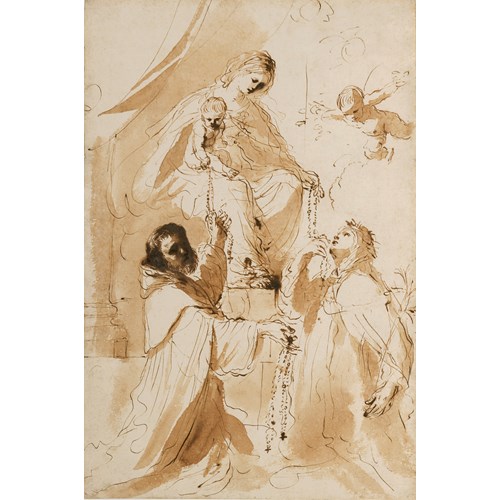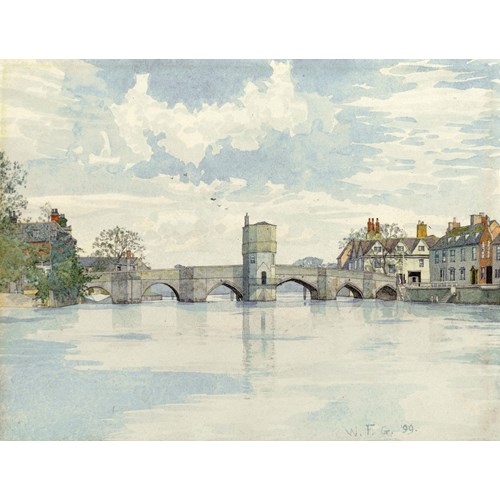Marketplace
The Head of a Man with a Cap, after Michelangelo
Battista Franco was a diligent copyist, and among his drawings are numerous studies of antique subjects, usually taken from reliefs on Roman sarcophagi. He also made copies after the works of Michelangelo, whose influence was to remain potent throughout his life. Indeed, much of Franco’s work in the early part of his career was indebted to his study of the pen drawings of the master. As Vasari noted of Franco, ‘he resolved that he would not study or seek to imitate any other works but the drawings, paintings, and sculptures of Michelagnolo; wherefore having set himself to make research, there remained no sketch, study, or even any thing copied by Michelagnolo that he had not drawn.’
Only recently rediscovered, thgis drawing by Franco faithfully reproduces a relatively little-studied drawing of a Profile Head by Michelangelo, datable to the middle of the 1520s, which is on the recto of a double-sided sheet in the Ashmolean Museum in Oxford. The two drawings match each other precisely in their dimensions, and it is likely that Franco worked with the original drawing in front of him. (Franco is thought to have had access to some of Michelangelo’s drawings through his friendships with the painter Raffaello da Montelupo, who worked as Michelangelo’s assistant in the 1530s and made copies of several of his drawings, and the sculptor Bartolomeo Ammannati, who is known to have owned some of the master’s original drawings.) In her unpublished 2004 thesis and catalogue raisonné of Franco’s oeuvre, the scholar Anne Varick Lauder identified some twenty-two drawings by the artist copied after original works by Michelangelo, to which the present sheet may now be added.
As the Michelangelo scholar Charles de Tolnay has noted of the Ashmolean drawing, ‘It is a martial head with an intensely passionate expression, emphasised by the rolling eye with the pupil in the corner, the strong cheekbones, the curved nose, the energetic chin. The hat is similar to those worn by Italian warriors during the first half of the 15th century, around 1420-30...Michelangelo, however, has transformed the almost symmetrical form of the headgear into a hat reminiscent in silhouette of that of the ancient Phrygians, bringing the top forward.’ While it has been suggested that the head in Michelangelo’s powerful drawing may have been copied from a Quattrocento painting or fresco by an artist such as Andrea del Castagno or Masolino da Panicale, no precise source has been identified. As Paul Joannides has opined of the Ashmolean sheet, ‘It could, in principle, reflect a quattrocento portrait but, on balance, it seems more likely to be an invention “in the manner of” than a copy.’
The contemporary fame of the Profile Head by Michelangelo is seen in the fact that it appears to have been one of the earliest drawings of which an engraved facsimile was made. An engraving in reverse after the Ashmolean drawing, by the anonymous Master GD and dated 1610, is known in just two impressions, one of which is in the Royal Collection at Windsor Castle. As Anthony Griffiths has written of the print, ‘It is of some interest in the history of engraving as being one of the first, if not the first, attempts to make an exact facsimile of a drawing. Such prints became common in the eighteenth century, when drawings were very widely collected, but are hardly known in the seventeenth.’ A second, somewhat damaged (proof?) impression of the engraving is in the collection of the Teyler Museum in Haarlem. The present drawing by Franco is, however, the only known drawn copy of Michelangelo’s Profile Head.
This drawing should be dated to the early part of Franco’s career, when the effect of Michelangelo on the young artist was particularly profound. As the Franco scholar Lauder has noted, ‘Michelangelo’s influence is perhaps most discernible in Franco’s earliest drawings executed in Rome and Florence in the 1530s, many of which are direct copies after Michelangelo’s sculptures and drawings or are Michelangelesque in style.’ The drawings of Franco’s maturity, while still often inspired by the example of Michelangelo, are much less likely to be direct copies of works by the master.
The attribution of the present sheet to Battista Franco has been confirmed by Anne Varick Lauder and Paul Joannides. Both scholars have compared the handling of this Profile Head in particular with another early pen drawing by Franco after Michelangelo; a study of Three Men in Conversation, which is in turn a direct copy of a drawing by Michelangelo in the Ashmolean Museum.
Only recently rediscovered, thgis drawing by Franco faithfully reproduces a relatively little-studied drawing of a Profile Head by Michelangelo, datable to the middle of the 1520s, which is on the recto of a double-sided sheet in the Ashmolean Museum in Oxford. The two drawings match each other precisely in their dimensions, and it is likely that Franco worked with the original drawing in front of him. (Franco is thought to have had access to some of Michelangelo’s drawings through his friendships with the painter Raffaello da Montelupo, who worked as Michelangelo’s assistant in the 1530s and made copies of several of his drawings, and the sculptor Bartolomeo Ammannati, who is known to have owned some of the master’s original drawings.) In her unpublished 2004 thesis and catalogue raisonné of Franco’s oeuvre, the scholar Anne Varick Lauder identified some twenty-two drawings by the artist copied after original works by Michelangelo, to which the present sheet may now be added.
As the Michelangelo scholar Charles de Tolnay has noted of the Ashmolean drawing, ‘It is a martial head with an intensely passionate expression, emphasised by the rolling eye with the pupil in the corner, the strong cheekbones, the curved nose, the energetic chin. The hat is similar to those worn by Italian warriors during the first half of the 15th century, around 1420-30...Michelangelo, however, has transformed the almost symmetrical form of the headgear into a hat reminiscent in silhouette of that of the ancient Phrygians, bringing the top forward.’ While it has been suggested that the head in Michelangelo’s powerful drawing may have been copied from a Quattrocento painting or fresco by an artist such as Andrea del Castagno or Masolino da Panicale, no precise source has been identified. As Paul Joannides has opined of the Ashmolean sheet, ‘It could, in principle, reflect a quattrocento portrait but, on balance, it seems more likely to be an invention “in the manner of” than a copy.’
The contemporary fame of the Profile Head by Michelangelo is seen in the fact that it appears to have been one of the earliest drawings of which an engraved facsimile was made. An engraving in reverse after the Ashmolean drawing, by the anonymous Master GD and dated 1610, is known in just two impressions, one of which is in the Royal Collection at Windsor Castle. As Anthony Griffiths has written of the print, ‘It is of some interest in the history of engraving as being one of the first, if not the first, attempts to make an exact facsimile of a drawing. Such prints became common in the eighteenth century, when drawings were very widely collected, but are hardly known in the seventeenth.’ A second, somewhat damaged (proof?) impression of the engraving is in the collection of the Teyler Museum in Haarlem. The present drawing by Franco is, however, the only known drawn copy of Michelangelo’s Profile Head.
This drawing should be dated to the early part of Franco’s career, when the effect of Michelangelo on the young artist was particularly profound. As the Franco scholar Lauder has noted, ‘Michelangelo’s influence is perhaps most discernible in Franco’s earliest drawings executed in Rome and Florence in the 1530s, many of which are direct copies after Michelangelo’s sculptures and drawings or are Michelangelesque in style.’ The drawings of Franco’s maturity, while still often inspired by the example of Michelangelo, are much less likely to be direct copies of works by the master.
The attribution of the present sheet to Battista Franco has been confirmed by Anne Varick Lauder and Paul Joannides. Both scholars have compared the handling of this Profile Head in particular with another early pen drawing by Franco after Michelangelo; a study of Three Men in Conversation, which is in turn a direct copy of a drawing by Michelangelo in the Ashmolean Museum.
Provenance: Private collection, London.
More artworks from the Gallery




 Birds of Asia Tits_T638451690185527753.jpg?width=500&height=500&mode=pad&scale=both&qlt=90&format=jpg)
 III_T637752695503075771.jpg?width=500&height=500&mode=pad&scale=both&qlt=90&format=jpg)



